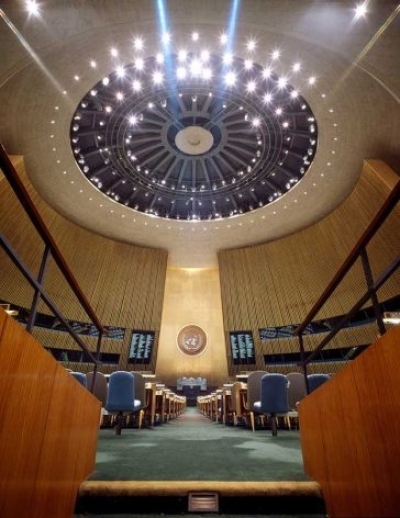Indian Prime Minister Narendra Modi arrived in Washington for a state visit this week. Beyond the black-tie dinner at the White House and a speech to Congress, there have been a lot of arms deals.
Jets, drones, cyber capabilities, and more.
It’s a significant list, and builds on an expanding military partnership. The US has partnered with India more and more in response to China’s rise, seeing New Delhi as a valuable counterweight. This is happening as India advances grievous human rights abuses against minorities, against journalists, and against political critics — all in contradiction of America’s stated values.
And yet this week, the White House is promoting a “next generation defense partnership” with India. This includes the co-production of cutting-edge technologies like jet engines and semiconductors, the prospect of new arms sales, and agreements that would allow the US to have its navy ships repaired in India. The country will also purchase 31 advanced drones from General Atomics in a deal that will cost some $3 billion. And the Pentagon and the Indian Ministry of Defense have established a new military-tech incubator called INDUS-X.
Experts point out that India under Modi increasingly does not share American values, and some of the advanced military technologies that the US is providing the country could be used against dissidents or journalists.
“If we’re just going to go full-on countering China with India as a realist approach to things, that can come back and bite us,” says Derek Grossman, a defense analyst at the RAND Corporation. “Because, as we saw during the Cold War, a lot of the dictators or semi-authoritarian regimes that we cozied up with, they were not our friends in the long run.”
US-India defense cooperation, very briefly explained
India built a relationship with the Soviet Union during the Cold War, and to this day, most of the Indian military’s weapons come from Russia. It wasn’t until the mid-2000s that India started buying arms from the United States, growing from around nothing in 2008 to $8 billion of US sales to the country by 2013, and to $20 billion in 2020.
Now, the new agreements will help create capacities for India as an arms producer. The Pentagon’s top Asia official, Ely Ratner, says the US was helping modernize the Indian military. The US Embassy in New Delhi described an initiative to “fast-track technology cooperation and co-production in areas such as air combat and land mobility systems, intelligence, surveillance, and reconnaissance, munitions, and the undersea domain.”
India wants to manufacture military and aerospace products. In this respect, the prospective General Electric engine deal represents a major change. Export controls and trade regulations have previously been a challenge for forging advanced production lines in India. “Engine technology is pretty sensitive,” says Vikram Singh of the United States Institute of Peace and the consulting firm WestExec Advisors. “This is a big, ambitious agenda.”
Both countries are eyeing China’s growing military and technological prowess, and the US is particularly concerned about the perceived threat of a Chinese invasion of Taiwan.
But Grossman, who previously spent a decade working on China policy at the Pentagon, says that the US goal of bolstering India’s defense is less about creating a partner who would actively participate in any US-China confrontation and actually more about India providing safe harbor on the continent. “What the United States is really looking for is access to India, in the case of a conflict against China,” he told me. “But the hope is that over time, as we continue our security cooperation, India will kind of bend a little bit, to be more flexible and maybe allow us access at certain times to certain places that can help us conduct operations.”
The US Navy established ship repair agreements with India that would enable the US to service its boats in Indian shipyards, with more agreements forthcoming, according to the White House. Grossman also emphasized that, in 2020, US Navy aircraft refueled on India’s base in the Andaman and Nicobar Islands. “They’re letting us do that in peacetime; why wouldn’t they let us do that when the stakes are much higher?” he said.
But even beyond the democratic issues, there are limits to how close this partnership could get in the near term. India remains non-aligned: It hasn’t taken a side in the Ukraine war, nor signed on to the sanctions against Russia. While India is a member of the “Quad,” an informal partnership with the US, Japan, and Australia, it is not a treaty ally of the United States. Grossman said that many in the Defense Department would like to see the US move toward a formal alliance with India.
That would be messy, notably because Pakistan is India’s prime rival and Pakistan is a close partner of the United States. Both countries have nuclear weapons, so if the US were to establish a treaty with India, the dynamics of a potential India-Pakistan conflict would be staggeringly complex for the US and dangerous for the world.
Nevertheless, the US military partnership with India has become a pillar of the Biden administration’s policy toward Asia. Interestingly, the US goes out of its way to not say it has anything to do with China, although analysts uniformly agree that it’s all about China. “The strategic environment that we’re facing in the Indo-Pacific challenges to peace and stability, I think those have animated a sense of Indian purpose more generally,” a senior US official, speaking on the condition of anonymity, told reporters.
The defense sector, unsurprisingly, is thrilled. Just ask the Asia Group, a consulting firm that advises clients like General Electric, Lockheed Martin, Northrop Grumman, and Raytheon and was founded by Kurt Campbell, who’s now the Biden White House’s point person on Asia policy.
Campbell’s former firm says the time is now to invest in India. “Companies that postpone entry or expansion in India might miss opportunities to maximize their long-term returns,” Gopal Nadadur, an Asia Group executive based in India, wrote recently. “Defense and aerospace companies like Airbus, Boeing, Dassault, General Electric, General Atomics, Raytheon Technologies and Pratt & Whitney have boosted their engineering and manufacturing operations in India.”
Will defense innovation make Asia safer?
Bringing in military-tech startups and investment firms has been a core strategy of the Pentagon in recent years, and that’s also now going to play a part in the US-India relationship. On Wednesday, the Chamber of Commerce hosted what it called an “innovation bridge” — the INDUS-X event.
US and Indian startups that focus on the military, aerospace, and satellites attended, alongside venture capital firms and major defense contractors like Raytheon and Boeing. The proceedings were sponsored by General Atomics, Lockheed Martin, and one of the big Indian companies, Mahindra Defence. The INDUS-X joint initiative will be “a catalyst for India to achieve its target of $5 billion in defense exports by 2025 and for India to diversify its defense supply chain,” according to the Chamber.
One of the keynote speakers, Secretary of the Air Force Frank Kendall, told attendees that he expected “huge growth,” in the two countries’ defense partnership, “the hockey stick curve that all entrepreneurs dream of.”
Participants did not directly discuss China, according to Pushan Das of the US-India Business Council, but it was the impetus for the gathering. “The reason why we’re doing all of this — the reason why there is the US-India defense-industry road map — it is because both countries have a common threat. They face a common challenge,” he told me. “And that’s pushing the defense relationship forward.”
But the focus on business interests has often meant that less attention has been paid in the commercial community to how increased military production and surveillance technologies in India could embolden Modi.
Modi is a Hindu nationalist leader who journalist Fareed Zakaria says is responsible for the decay of Indian democracy. His attacks on political rivals, the press, and minorities call into question the strategic benefits of growing military cooperation with the country. To cite a recent example, India arrested Vivek Raghuvanshi, a contributor to the US-based outlet Defense Times, in May.
Senior Biden administration officials told a press conference that raising human rights concerns would be part of President Biden’s private conversations with Modi, but declined to provide specificity. Human rights concerns did not come up in the conversations at INDUS-X, according to Das, and Air Force Secretary Kendall did not raise them in his remarks.
Singh, who worked in the Obama Pentagon, says that pragmatism is necessary to counter China. “We look at Prime Minister Modi, like a lot of other complicated partners, be it in Southeast Asia, like Vietnam or Thailand, or in Europe, like Poland, or Hungary, or Turkey,” he told me. “But I think we’ve reached a point where American leaders are able to talk to Indian leaders about these sorts of concerns.”
There’s also another risk of flooding India with arms that Campbell, who served in the Obama State Department, warned of in his 2016 book The Pivot: The Future of American Statecraft in Asia.
“China and India both remain under 2 percent of GDP for defense spending, while, for comparison, between 2009 and 2013, US Defense spending averaged 4.4 percent of GDP,” he wrote. “If Asian powers were to devote the same proportion to defense spending as the United States, the region would quickly become even more dangerous.”






